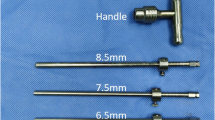Abstract
Purpose
Compared to the ligamentum flavum (LF), morphology of the epidural membrane (EM) and the periradicular fibrous tissue (PRFT) has been largely ignored in studies of lumbar spinal stenosis (LSS). The aim of this prospective study was to elucidate the morphologies and clinical importance of the EM and PRFT in LSS.
Methods
Before starting this study, neural compressive EM (c-EM) and PRFT (c-PRFT) were defined as follows based on our microsurgical experience and a literature review. The c-EM is a constriction band or membrane obstructing dural tube expansion, and the c-PRFT is a fibrous tissue that compresses the nerve root and/or restricts its mobility. This study enrolled 134 patients who underwent microscopic decompression at L4/5. The morphologies of each patient’s EM and PRFT were observed and recorded. Specimens were obtained from randomly selected patients for histological evaluation.
Results
The EM and PRFT exhibited a wide morphological spectrum, from a fine strand to a substantial membrane. The c-EM alone was observed in four cases, the c-PRFT alone in 37 cases, and both in three cases. The c-PRFT was more frequently observed in patients with degenerative spondylolisthesis than in those without olisthesis (P < 0.05). Several cases exhibited interesting histological findings including many small arteries, chondrometaplasia, ganglion-like cyst formation, and hyalinized collagen fibers.
Conclusions
Some EM and PRFT transform into degenerative and substantial fibrous tissues during the process of symptomatic LSS development. Such morphological and histological changes can cause dural tear, symptomatic epidural hematoma, and/or inadequate decompression.



Similar content being viewed by others
References
Spencer DL, Irwin GS, Miller JA (1983) Anatomy and significance of fixation of the lumbosacral nerve roots in sciatica. Spine 8:672–679
Kikuchi S, Hasue M, Nishiyama K et al (1984) Anatomic and clinical studies of radicular symptoms. Spine 9:23–30
Wiltse LL, Fonseca AS, Amster J et al (1993) Relationship of the dura, Hoffmann’s ligaments, Batson’s plexus, and a fibrovascular membrane lying on the posterior surface of the vertebral bodies and attaching to the deep layer of the posterior layer of the posterior longitudinal ligament—an anatomic, radiologic, and clinical study. Spine 18:1030–1043
Miyauchi A, Sumida T, Manabe H et al (2012) Morphological features and clinical significance of epidural membrane in the cervical spine. Spine 19:E1182–E1188
Beamer YB, Garner JT, Shelden CH (1973) Hypertrophied ligamentum flavum. Arch Surg 106:289–292
Yoshida M, Shima K, Taniguchi Y et al (1992) Hypertrophied ligamentum flavum in lumbar spinal canal stenosis. Spine 17:1353–1360
Abbas J, Hamoud K, Masharawi YM et al (2010) Ligamentum flavum thickness in normal and stenotic lumbar spines. Spine 35:1225–1230
Luyendijk W (1976) The plica mediana dorsalis of the dura mater and its relation to lumbar peridurography (canalography). Neuroradiol 11:147–149
Savolaine ER, Pandya JB, Greenblatt SH et al (1988) Anatomy of the human lumbar epidural space: new insights using CT-epidurography. Anesthesiol 68:217–220
Blomberg RG, Olsson SS (1989) The lumbar epidural space in patients examined with epiduroscopy. Anesth Analg 68:157–160
Hogan QH (1991) Lumbar epidural anatomy. Anesthesiol 75:767–775
Richardson J, McGurgan P, Cheema S et al (2001) Spinal endoscopy in chronic low back pain with radiculopathy. Anaeshesia 56:454–460
Igarashi T, Hirabayashi Y, Seo N (2007) Epiduroscopic findings. The pain clinic 19:171–177
Solaroglu I, Okutan O, Beskonakli E (2011) The ATA and its surgical importance: a newly described ligament lying between the dural sac and the ligamentum flavum at the L5 level. Spine 36:1268–1272
Shi B, Li X, Li H et al (2012) The morphology and clinical significance of the dorsal meningovertebral ligaments in the lumbosacral epidural space. Spine 37:E1093–E1098
Author information
Authors and Affiliations
Corresponding author
Ethics declarations
Conflict of interest
No external funding was received or used to support this study. None of the authors has any conflicts of interest to report that are directly related to the specific subject matter of this manuscript.
Rights and permissions
About this article
Cite this article
Miyauchi, A., Sumida, T., Kaneko, M. et al. Morphology and clinical importance of epidural membrane and periradicular fibrous tissue in lumbar spinal stenosis. Eur Spine J 26, 382–388 (2017). https://doi.org/10.1007/s00586-016-4640-z
Received:
Revised:
Accepted:
Published:
Issue Date:
DOI: https://doi.org/10.1007/s00586-016-4640-z




